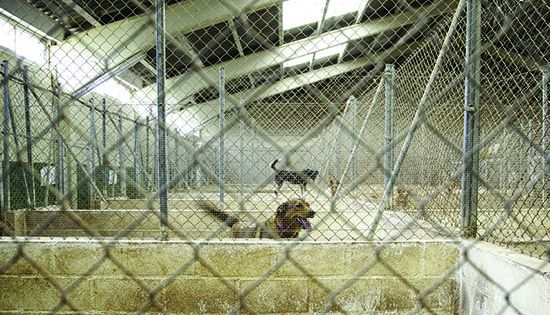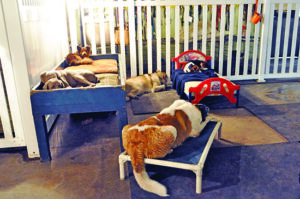
Once upon a time, all commercial boarding kennels closely resembled old-school animal shelters or puppy mills – you know, a row of narrow chain-link pens on concrete inside a loud building or under a barn roof. Fancy ones might contain a hard cot-style bed and dog doors that led to equally narrow individual outdoor runs. But, nearly always, the dogs had to endure the unspeakably stressful proximity of many other stressed dogs, and generally had to eliminate in their pens, which were hosed out while the dogs dodged for cover. Owners who had no other options (other than not traveling) comforted themselves with the idea that at least their dogs were securely contained and fed.
The good news is that we have many more options today, including boarding “hotels” that may offer our dogs more comfort and enrichment than they enjoy in our own homes. The bad news is that not all of the employees (or even operators) of these businesses may be highly experienced with or knowledgeable about canine behavior and low-stress dog handling. Here’s what to look for when shopping for a dog-boarding facility that will keep your dog secure, comfortable, and unharmed.
RESEARCH AND TOUR YOUR DOG BOARDING FACILITY
It’s important to research and tour prospective boarding facilities well before you need one. Start by checking online reviews – keeping in mind that even the world’s best businesses suffer bad reviews from a few unhinged people with axes to grind. Check with the Better Business Bureau; generally (but not always), complaints lodged with the BBB can be taken more seriously than Yelp-style complaints. Ask dog professionals you respect (vets, trainers, groomers, etc.) if they have information or opinions about the boarding facility.
Next, call the business to schedule a tour. Online photos and videos of the facility may help you select which businesses you want to check out, but nothing is a replacement for seeing (and hearing) the boarded dogs in real time, seeing how the staff members interact with the dogs, and having an opportunity to see how the facility looks and smells in the middle of a business day.
Be forewarned: Many dog daycare and boarding facilities decline to conduct tours, citing the disturbance to their guest dogs and the possibility of a visitor bringing a pathogen into the facility. Understandably, this practice has gotten even more widespread since Covid.
We appreciate the need to protect dogs and staff from infections, and that the appearance of unfamiliar people can cause some excitement among boarded or daycare dogs, but if we can’t see where our dogs are going to be spending their time, or see in action some of the people who will be handling them, we’re not leaving our dogs there. Disposable booties or a disinfectant shoe-bath can be used protect the dogs, and masks and hand-sanitizer can be employed to protect the staff.
You need to see where your dog will be housed and where he will be taken to eliminate and/or recreate. When viewing the accommodations, pay particular attention to:
- The infrastructure that secures the facility. How tall are the fences in the outdoor yards and are they in good repair? Could a dog escape the facility if a single door or gate was improperly latched? (There should be at least two gates or doors between every place dogs are kept and an exit from the property.) Could an unauthorized person enter the facility and steal a dog? (There should be locked doors or staff present to ensure that no unauthorized persons can enter.)
- The cleanliness of the facility. Pay attention to how the business looks and smells. Does it appear to be clean? Ask how is it sanitized, and how often?
- The comfort of the area where your dog will be kept. Does the room seem to have an adequate air supply and climate control? Is the temperature comfortable? What separates the dogs’ individual enclosures; can the dogs see each other? (It’s highly stressful for dogs to both see and be seen by strange dogs while trapped in a small space.) What sort of bedding will your dog have? Is there an ample and spill-proof supply of water in each dog’s enclosure?
If the enclosures have no direct access to an outdoor potty area, ask how frequently dogs are taken outside or if they’re expected to eliminate in the enclosure. If the latter, how often are the enclosures cleaned and where are the dogs during the process?
- Check to see what, if any, “comforts” are provided (beds, blankets, toys, and chews). Do the enclosures resemble bare prison cells, or are the dogs given cushy beds?
- Discuss the dogs’ exercise options. Many kennels offer the option of recreational play groups. When considering this option, find out how guests are screened to determine their eligibility for play groups. As with daycare and cage-free facilities, play groups must be closely supervised at all times by well-trained staff.
How large are the play groups? How are play pals selected? How much time do dogs spend engaged in off-leash play? What is the procedure for breaking up a dog fight and how are dogs handled immediately following, as well as for the duration of their stay? Are owners notified? If you don’t wish for your dog to participate in a play group, how will your dog be exercised?
- Ask about the dogs’ meals. Does the kennel require that all guests eat a facility-provided kibble, or can owners bring their pet’s food from home? Will the kennel accommodate special diets such as home-cooked meals or raw food, and do they charge extra for this?
- Ask about the kennel’s policy regarding sick or injured dogs. Every kennel should maintain excellent working relationships with local veterinarians and 24-hour care facilities. Find out how emergencies or potential emergencies are handled. When vet care is needed, are owners contacted ahead of time? For minor issues, how is the need for vet care decided and by whom?
- What are the staff hours? Are there times when the dogs are not being monitored by a present and awake staff member? Not all facilities provide overnight monitoring for their canine guests.
- Inquire about emergency plans. Fires, floods, earthquakes, tornadoes – emergencies can strike anywhere and at any time. Make sure the facility has detailed emergency plans in place. Can they safely evacuate guests in the event of a natural disaster? Where are the animals evacuated to? Are client records backed up off-site so that owners can be notified of an evacuation should the facility be compromised?
- Last but not least: Ask about the training of the staff. In the kennel industry, a well-trained and competent staff is what ensures the health and safety of your pet. A love of dogs isn’t an adequate job qualification! Kindness, patience, compassion, and an ability to keep one’s own emotions in check are all important traits that must be combined with a solid understanding of dog behavior and a natural ability with dogs. This is critical in facilities that allow dog-to-dog interaction among guests.
Ask about the training that the employees receive and how much (if any) continuing education is required. Are they required to complete any sort of educational modules or classes about dog behavior, Fear Free handling, or pet first aid? Facility staff should be skilled in the nuances of dog body language; how to recognize, prevent, and interrupt bullying; and how to safely break up a dog fight.
Note: Unless you board your dog at your usual, familiar trainer’s facility, we suggest that you not authorize training during boarding, unless you have taken the time to thoroughly screen the trainer and her methods.
If, on a tour of the facility that you are considering for boarding your dog, you see any of the following, continue your search for another candidate for your business. There are more boarding options today than ever; even if you have to drive your dog some distance to a high-quality kennel, it’s worth the trouble. Your dog’s life is literally in the hands of these people!
- You aren’t allowed to see where your pet will be housed. Some facilities cite insurance reasons for keeping owners out of the kennel area, but at a minimum, you should be allowed to look through a door or window and see the area where your pet will stay.
- Dirty facility. Pet messes should be cleaned up promptly and adequate air circulation (necessary for the good health of your pet) should prevent an overall “doggy” smell. In general, the facility should appear neat and clean and should not have an unpleasant odor.
- Inattentive staff. Their top priority should be the dogs. It’s a bad sign if the one person watching a play group of dogs is suddenly the same person giving you a tour of the facility!
- Excessive barking. It’s reasonable to expect bursts of barking when a human or dog travels through the kennel area. Continued barking likely points toward a bigger problem such as lack of exercise, lack of mental stimulation, inadequate potty opportunities, or an overall high stress/anxiety level.
- Inappropriate handling, such as physical or shouted “corrections.” Experienced, well-educated dog handlers don’t need to hit or “alpha-roll” dogs, ever.
YOUR DOG’S INTERVIEW

Turnabout is fair play: If you’ve found a boarding business that you’d feel good leaving your dog with, the next step is to make sure the boarding business has an opportunity to meet your dog and learn as much about him as possible before taking responsibility for his well-being.
Many boarding businesses have an evaluation process that must be completed in advance of your dog’s stay, to ensure he’s a good fit for the kind of care they provide – and they may charge a nominal fee for conducting this evaluation. Some require that your dog spend some minimum amount of time with the facility in a daycare arrangement prior to being boarded overnight – again, to make sure that your dog is ready and capable of spending time comfortably in the type of accommodations that the business offers.
Be ready to disclose whether your dog has ever had any incidents of aggression with other people or dogs. Don’t hide or gloss over this information. If your dog has a fight or bite history, his handlers need to know, so he’s not unwittingly set up to fail and put into a situation that’s beyond his ability to handle.
PREPARING YOUR DOG FOR BOARDING
Find out, well in advance of your travel plans, what vaccinations are required by the boarding kennel. Most require that some vaccines be given two or more weeks in advance of the dog’s stay (because it takes about that long for the dog to develop immunity after vaccination). If your dog is a senior or has a chronic health condition, you may want to ask what, if any, vaccination exceptions exist. As thoughts regarding vaccination evolve, many kennels now accept titers or statements of vaccine exclusion from a veterinarian in lieu of following a strict vaccination protocol.
Be prepared to provide emergency contact numbers (including your veterinarian’s contact information) – and make sure the people you list are ready, willing, and able to respond quickly if the facility calls regarding an emergency concerning your dog.
It’s helpful if the boarding facility offers daycare, too, so your dog can spend a day or two at the facility before spending nights there, too. If the business does not offer daycare, book an overnight stay for your dog when you are in town, so you’re available to pick up your dog if it turns out he is overly stressed.
Avoid dietary changes in the days prior to boarding. The initial stress of boarding often leads to digestive upset; don’t do anything that might add to this!
If possible, try to avoid contact with other dogs for seven to 10 days prior to boarding. This helps prevent the possibility of exposure to disease that could then be introduced into the kennel environment.
Most daycare and boarding facilities remove clients’ collar, and leave the dogs either naked or in breakaway collars (to prevent entanglement during group play). For this reason, we recommend that your dog is implanted with a microchip ID (registered with your current phone number), or tattooed with information that can quickly lead a rescuer to you, should any disaster lead to your dog’s escape.
GO WITH YOUR GUT
Once you’ve done your homework and thoroughly checked out your list of potential facilities, often the best way to make a selection is to go with your gut instinct. If deciding between two different facilities that seem equal in terms of experience and standards of care, ask yourself if one just simply feels better? If for any reason you feel uncomfortable with a facility, trust yourself and your ability to know what’s best for your dog.






Liked this article. Well thought out and simply addressed. Trying to locate a sufficient boarding spot now. Trusting your gut was a great comment and so true. Found a place that won’t allow a tour or visits…..hmmmm. Not feeling comfortable with that.
Very good article. Especially good advice for newbies. I wish I had this advice years ago before having our first dog boarding experience.
As a professional pet sitter, I’m discouraged to see that this article did not touch on keeping your dog at his/her home with a professional and qualified professional sitter to check in on them 3 to four visits a day. This option is the least stressful on both dogs and owner.
The interview process should be similar and usually a qualified pet sitter will be insured and bonded, perhaps even Pet CPR and First Aid trained. You can tell instantly if this person will get along with your dog and they have everything they need in your own home.
Before I was a pet sitter, I used the services of one for my aging dogs and young parrot. I could text her anytime for updates and pictures. I knew they were happy being home.
Please think about a staycation for your pets next time you go away.
Yes Beaglegirl18! For us, a pet sitter in our home is the way to go!
Years ago I toured a kennel when we were going to Paris for 10 days. It was like a jail cell. Chain link on concrete with a small run. Dogs barking their heads off. I could never leave my beloved dog there. She would have thought I abandoned her. Instead, a friend from work took her to her house and took great care of her. A couple of years later, I got a pet sitter to watch her when we took another trip. Now I have a bunny, chickens and 2 dogs so we always get a pet sitter. I have 2 people that I use, both are licensed and insured and my dogs like them. Well worth the peace of mind!
I would also suggest crate training your dog. That way, they are used to a crate and many dogs feel safe in crates.